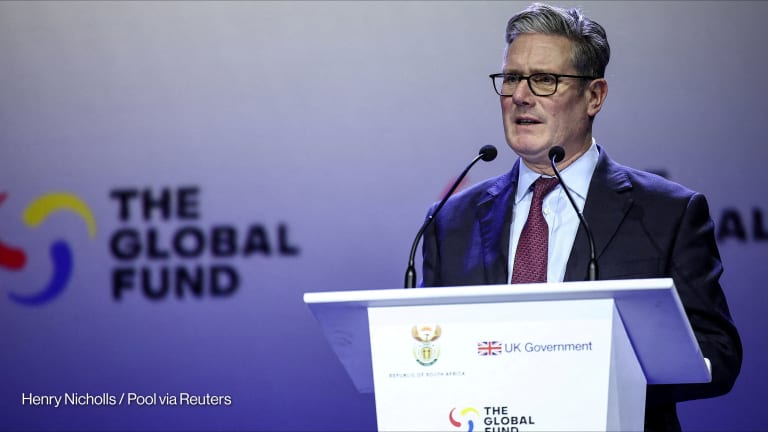DevExplains: How NGOs can access Global Fund grants
The Global Fund hopes to send country allocation letters before the year ends, which kicks off the whole funding request process.
The board of the Global Fund to Fight AIDS, Tuberculosis and Malaria has recently approved total country grant allocations for 120 countries for the next three years, with an amount of $13.2 billion — slightly higher than the $12.7 billion that the board approved for the current funding cycle. The next step now is for the Global Fund to identify how much funding each country will receive. Global Fund hopes to send the allocation letters before the year ends, which kicks off the whole funding request process. Devex spoke with Lindsay Smith, the manager of communication and information management at the access to funding department of the Global Fund, to learn how the whole process works and to provide guidance to NGOs — particularly first-timers — on how to access Global Fund grants. She said that in a resource-constrained environment “We need to make sure that we're really listening to the voices that can help us drive impact with the funding that is available.” Who’s involved in the Global Fund funding request process? There are three important entities in countries involved in the funding request cycle that NGOs should know about. They include the country coordinating mechanisms, the principal recipients, and the subrecipients. Country coordinating mechanisms, more commonly referred to as CCMs, are an important point of contact for NGOs wishing to access Global Fund grants in a given country. These committees engage with the Global Fund on funding requests, choose the principal recipients implementing the grants, and oversee grant implementation. CCMs are a group of people representing different organizations and institutions, including academe, NGOs, civil society, faith-based organizations, government, multilateral and bilateral agencies, the private sector, and people living with the disease. Principal recipients are the ones that sign the actual grant with the Global Fund. They can be a government entity, a local or international NGO, a private sector entity, a multilateral agency, or a bilateral agency. Although according to Global Fund guidelines, priority should be given to local and legal entities from the public or the private sector, or civil society. Locally incorporated international NGOs are also considered local entities. Subrecipients or sub-subrecipients, which help implement programs funded by Global Fund grants, can also include NGOs. “A potential implementer who is already working in a particular country can certainly reach out to the CCM … to express interest in being involved in country dialogue.” --— Lindsay Smith, manager of communication and information management, Global Fund’s access to funding department How much is available for HIV, TB, and malaria? The allocation letters will include not just the total allocation per country, but also how much of it goes to HIV, TB, and malaria, depending on what diseases a country is eligible to apply for. This is not final, however, and CCMs can communicate to the Global Fund whether they accept the disease split allocation, if they would like to shift funding between diseases, or designate specific funding for resilient and sustainable systems for health programming. A new component in the funding request for the new cycle is that CCMs will need to identify how much of the funding for each disease will be spent to address gaps in the health and community systems. But globally, for 2023-2025, 50% of the $12 billion approved grant funding will go to HIV and AIDS, 32% to TB, and 18% to tuberculosis. Any additional available funds for country allocation above $12 billion will be allocated as follows: 45% will go to HIV and AIDS, 30% to malaria, and 25% to TB. The process Funding requests to the Global Fund take place throughout the funding cycle. This is because countries have different grant implementation timelines. For example, the implementation period for current Global Fund grants in Kenya that started in 2021 ends in 2024, while grants in the Philippines ends in 2023. This means the Philippines can start applying for new grants earlier than Kenya. But funding requests take place after a country dialogue, which is a key requirement in accessing Global Fund grants. CCMs are responsible for coordinating a country dialogue, which needs to be inclusive and transparent, according to Smith. This means it should involve a broad range of entities, including vulnerable populations, NGOs, and experts in different areas that could contribute to a better understanding of the country’s needs and funding priorities. Interested NGOs should take part in this dialogue if they aren’t already involved. CCMs need to include a description of the country dialogue that took place and who were involved when they make the funding request to the Global Fund. This is to demonstrate that an inclusive and transparent dialogue took place in the development of the funding request. CCMs also need to demonstrate that a transparent process took place in identifying the principal recipient — the ones responsible for implementing Global Fund grants. Principal recipients are the ones responsible for identifying subrecipients or sub-subrecipients. “An NGO could put themselves forward as a strong candidate to be an implementer. But maybe that's a principal recipient or maybe that's a subrecipient or maybe that's a sub-subrecipient, depending on the area of expertise of an NGO,” Smith said. CCMs however can reselect well-performing principal recipients without going through a broad open call for proposals. According to Smith, more than 70% of Global Fund principal recipients are well-performing and have continued from one funding cycle to another. But that’s not to say there aren’t opportunities. “If in the funding request, the CCM identifies that there has been an area that … needs strengthening or there's an area that is new from the Global Fund’s new strategy that they want to integrate into the overall programming, they may indeed be looking for a new implementer to be either a principal recipient, but more likely a sub- or sub-subrecipient for that specific new area,” she said. The new strategy puts greater emphasis on meeting the needs of people and communities, integrating programs, and addressing health inequities as well as human rights and gender barriers to health. The new strategy also allows the Global Fund to continue playing a role in pandemic preparedness and response and integrate climate change into its work. According to Smith, the Global Fund doesn’t have an overview of what opportunities are and will be available for new implementers. There is, however, contact information for CCM focal points on its website. “A potential implementer who is already working in a particular country can certainly reach out to the CCM, and this would be a great time to do that — to express interest in being involved in country dialogue and to express interest in being a potential implementer,” she said. According to Smith, some CCMs have already started country dialogue discussions, to be able to submit funding requests as early as March 20, 2023, the first date of submission for funding requests under the 2023-2025 funding cycle. The Global Fund recommends countries with grants ending by December 2023 to make their funding requests during this window to leave enough room for grant review and board approval process, as well as any contractual negotiations, implementation arrangements, and the signing of the grants, which can take time. Smith said country dialogues should start as early as 10 or 11 months before a country’s current grant ends, and funding requests should be submitted nine or eight months before the current grant ends. She encourages NGOs not yet connected to CCMs in countries where they are operating to do so and involve themselves in country dialogue, especially if they work with populations affected by HIV, TB, and malaria or have expertise in health and community systems. “Because we will go into the next allocation cycle knowing that in a resource-constrained environment, where we have changes in currencies that will result in buying power being decreased, and the cost of health products going up, we know we need to make every dollar work harder,” she said.
The board of the Global Fund to Fight AIDS, Tuberculosis and Malaria has recently approved total country grant allocations for 120 countries for the next three years, with an amount of $13.2 billion — slightly higher than the $12.7 billion that the board approved for the current funding cycle.
The next step now is for the Global Fund to identify how much funding each country will receive. Global Fund hopes to send the allocation letters before the year ends, which kicks off the whole funding request process.
Devex spoke with Lindsay Smith, the manager of communication and information management at the access to funding department of the Global Fund, to learn how the whole process works and to provide guidance to NGOs — particularly first-timers — on how to access Global Fund grants.
This story is forDevex Promembers
Unlock this story now with a 15-day free trial of Devex Pro.
With a Devex Pro subscription you'll get access to deeper analysis and exclusive insights from our reporters and analysts.
Start my free trialRequest a group subscription Printing articles to share with others is a breach of our terms and conditions and copyright policy. Please use the sharing options on the left side of the article. Devex Pro members may share up to 10 articles per month using the Pro share tool ( ).
Jenny Lei Ravelo is a Devex Senior Reporter based in Manila. She covers global health, with a particular focus on the World Health Organization, and other development and humanitarian aid trends in Asia Pacific. Prior to Devex, she wrote for ABS-CBN, one of the largest broadcasting networks in the Philippines, and was a copy editor for various international scientific journals. She received her journalism degree from the University of Santo Tomas.








